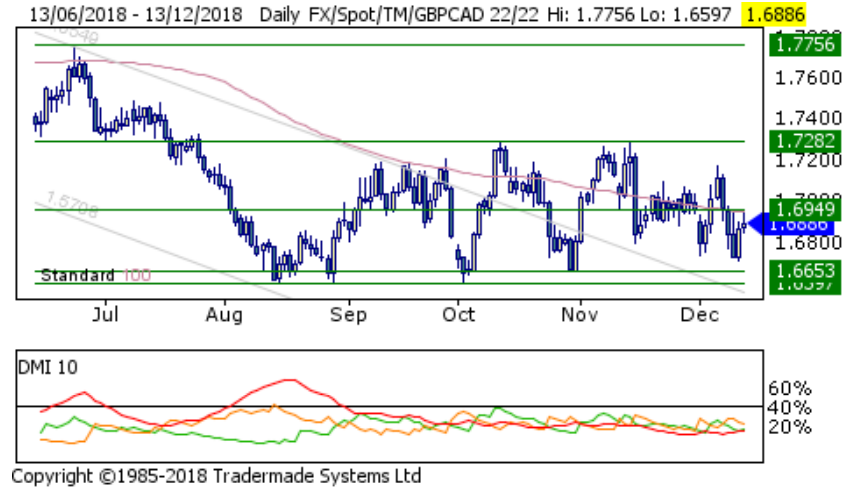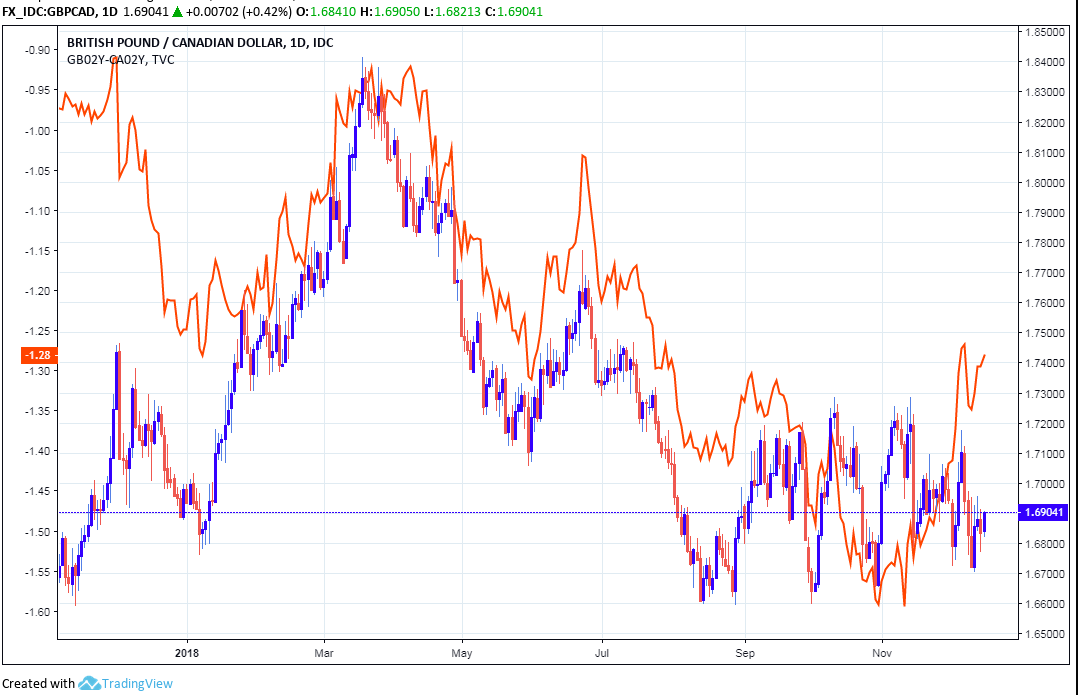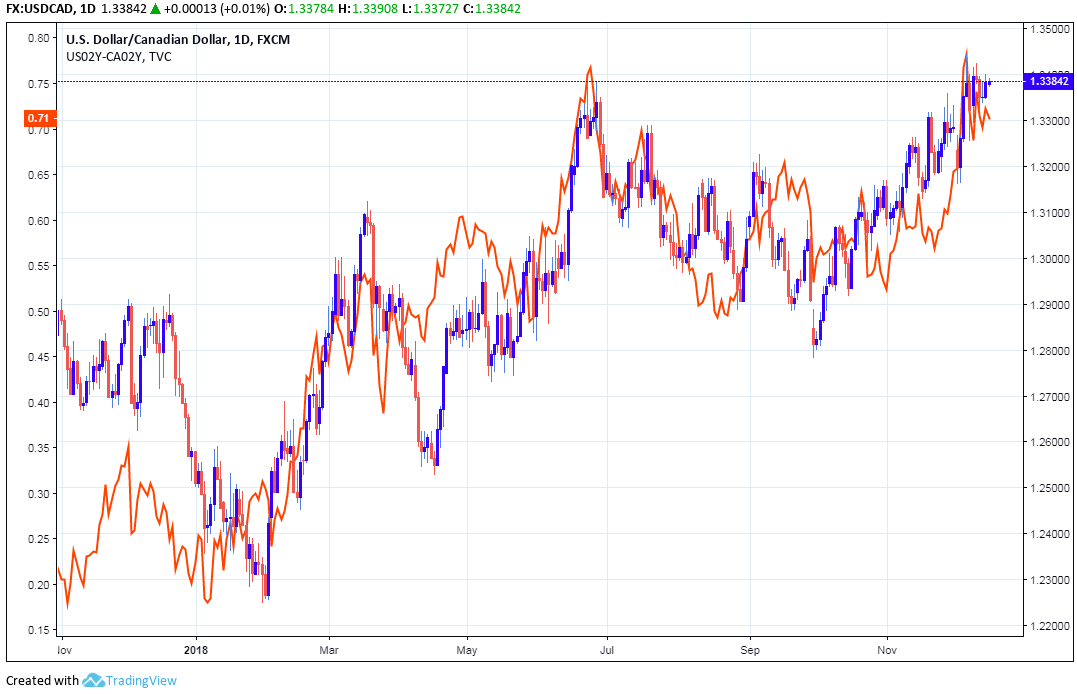The Pound-to-Canadian-Dollar Rate in the Week Ahead: One Last Big Test Awaits
- Written by: James Skinner
-

Image © Bank of Canada
- CAD treads water ahead of its final big test for the 2018 year.
- Inflation and GDP data are key to BoC outlook for New Year.
- And will set direction for the CAD into year-end and beyond.
The Canadian Dollar has spent December on its back foot although the downtrend is losing momentum, but all of this could change before over coming days because one last big test now awaits the Loonie during the week ahead.
Canada's Dollar has fallen to an 18-month low against the greenback this December but Sterling's own unique weakness has ensured the Pound-to-Canadian-Dollar rate did not capitalise on that decline.
This left the Pound-to-Canadian-Dollar rate trading at exactly the same level it was at in January 2018, although the days ahead will be decisive for the exchange rate's annual performance.
"This cross, like other CAD markets, is showing little in the way of strong, directional intent and, back to the middle of the range, is giving investors a pretty poor risk/reward proposition in the short run at least," says Shaun Osborne, chief currency strategist at Toronto-headquartered Scotiabank. "The GBP has been choppy around the 1.6950 area since Sep but we think longer term price signals still suggest a little more downside risk."
Osborne and the Scotiabank team are 'neutral' in their outlook for the Pound-to-Canadian-Dollar rate. They say there is little that suggests an imminent improvement in the rate at the moment but that earlier losses mean betting on further declines looks too risky from where they are stood.

Above: Scotiabank technical analysis of Pound-to-Canadian-Dollar rate.
Canadian GDP and inflation numbers covering October and November are due for release on Wednesday and Friday respectively, and markets will use them to gauge whether the Bank of Canada (BoC) will raise its interest rate again in January, or if it will wait until April next year.
In other words, a large part of the 2019 Canadian interest rate outlook will be determined during the week ahead, with implications for the currency. But given the extent of losses seen earlier this month Canada's Dollar could now be more sensitive to good news than bad.
"After last week’s sharp dovish turn by the Bank of Canada, the market is now pricing just over one 25 bp hike by the end of 2019. That’s a huge shift from over two hikes priced just a month or two ago," says Greg Anderson, head of FX strategy at Toronto-headquartered BMO Capital Markets.
The interest rate outlook has deteriorated since October, leading the difference or 'spread' between yields on Canadian government bonds and those of their British and U.S. counterparts to move in favour of the rival currencies.

Above: GBP/CAD (red & blue) at daily intervals with 2-year GB-Canada yield spread.
The Pound-to-Canadian-Dollar rate was 0.44% higher at 1.6890 but has declined -0.28% for the year.
The USD/CAD rate was quoted -0.01% lower at 1.3385 Monday but is now up by 6.42% for the 2018 year.
The orange line shown on the charts above and below represents the short-term bond yield differential or 'spread'.
Both charts show spreads moving against the Canadian currency but data due this week will be key to whether this trend remains in place into year-end.

Above: USDCAD (red & blue) at daily intervals with 2-year U.S.-Canada yield spread.
Canada's inflation rate is expected to decline by 10 basis points to 2.3% for the month of November when the data are published on Wednesday at 13:30.
That would suggest inflation pressures are waning although it will still leave the consumer price index above the BoC's 2% target so may not have an adverse effect on the Loonie.
October's GDP data released at the same time on Friday will be more important for the currency, particularly in light of the global oil price collapse that began to gather pace that month.
Consensus is for the economy to have grown by 0.2% in October, reversing the -0.1% contraction seen in September, although it will take a sizeable beat against expectations to have an impact on forecasts for the BoC.
"We’re betting on a GDP rebound to +0.3% after the prior month’s outright decline. We have oil production declines ahead in November/December, so the quarter desperately needs a great start for other sectors," says Avery Shenfeld, chief economist at Toronto-headquartered CIBC Capital Markets. "Cool headline CPI data won’t make waves as long as core holds at 1.9%."
Advertisement
Bank-beating exchange rates. Get up to 5% more foreign exchange by using a specialist provider to get closer to the real market rate and avoid the gaping spreads charged by your bank when providing currency. Learn more here
Bank of Canada in Focus
The Bank of Canada raised its interest rate by 25 basis points to 1.75% in October and said it will go on lifting its benchmark rate over coming quarters, potentially taking the cash rate up to 3.5%.
But Canada's central bank effectively backed away from that guidance in December following a series of disappointing economic figures and in the wake of a boom-to-bust collapse in the oil market.
That retreat has been the main driver of the adverse shift in bond yield-spreads that sent the Canadian Dollar tumbling in November and early December.
Canada's economy is dependent on exports of oil but Western Canadian Select has fallen to new record lows this year, prompting the Alberta government to require producers to cut production in order to lift prices.
The production cuts are now expected to dent GDP growth at the beginning of next year, at a time when the currency market is looking for a pick up to compell the Bank of Canada to keep raising its interest rate over coming months.
"2019 GDP growth profile is going to see volatility due to swings in oil production. The production cuts mandated by the Province of Alberta are going to hit GDP in Q1. However, the impact should be temporary and, if the rest of the economy holds up, activity should improve starting in Q2," says Anderson.
Pricing in interest rate derivatives markets, which among other things provides insight into investor expectations for monetary policy, has shown a clear deterioration in the interest rate outlook since the beginning of October.
Market-implied interest rates suggested at the beginning of October there was almost a 100% probability the BoC would lift its interest rate to 2% on January 09, 2019. But this week the implied probability of a January hike is almost zero.
In fact, it is now September 2019 before another BoC rate hike is fully reflected in interest rate derivative market pricing. The implied rate for April 24, 2019 is just 1.84%, suggesting a little less than a 50% probability of a hike by that time.
This weeks economic data will have an impact on that pricing and as a result, bond yield-spreads and the Canadian Dollar too.
However, whether it aughurs a further deterioration in the market outlook or a turn for the better still remains to be seen.
Advertisement
Bank-beating exchange rates. Get up to 5% more foreign exchange by using a specialist provider to get closer to the real market rate and avoid the gaping spreads charged by your bank when providing currency. Learn more here




